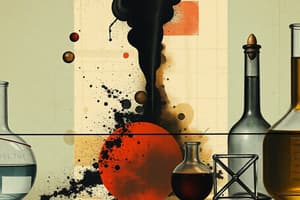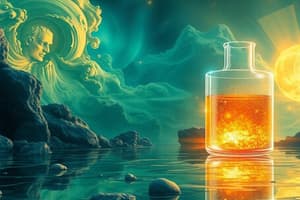Podcast
Questions and Answers
What effect does increasing the concentration of reactants have on the equilibrium of a reaction?
What effect does increasing the concentration of reactants have on the equilibrium of a reaction?
- It favors the reverse reaction, shifting the equilibrium left.
- It causes the equilibrium to shift left.
- It favors the forward reaction, shifting the equilibrium right. (correct)
- It has no effect on the equilibrium.
How does the equilibrium shift when the volume of a container is decreased?
How does the equilibrium shift when the volume of a container is decreased?
- It shifts to the side with fewer gas molecules. (correct)
- It shifts to the side with more gas molecules.
- It shifts towards the reactants.
- It remains unchanged in all cases.
In an exothermic reaction, what happens to the equilibrium when the temperature is decreased?
In an exothermic reaction, what happens to the equilibrium when the temperature is decreased?
- The equilibrium remains unchanged.
- The equilibrium shifts to the right. (correct)
- The equilibrium shifts to the left.
- The equilibrium shifts towards reactants and away from products.
Which of the following stresses does NOT affect the equilibrium of a chemical reaction?
Which of the following stresses does NOT affect the equilibrium of a chemical reaction?
What is the effect of increasing the temperature in an endothermic reaction?
What is the effect of increasing the temperature in an endothermic reaction?
If the reaction A(g) + 3B(g) ⇌ 2C(g) + heat experiences a decrease in pressure, in which direction will the equilibrium shift?
If the reaction A(g) + 3B(g) ⇌ 2C(g) + heat experiences a decrease in pressure, in which direction will the equilibrium shift?
What is the impact of decreasing the concentration of products in the equilibrium A(g) + 3B(g) ⇌ 2C(g) + heat?
What is the impact of decreasing the concentration of products in the equilibrium A(g) + 3B(g) ⇌ 2C(g) + heat?
In which scenario will the equilibrium shift towards the reactants?
In which scenario will the equilibrium shift towards the reactants?
Flashcards
Le Chatelier's Principle
Le Chatelier's Principle
A principle stating that a system at equilibrium will shift to relieve stress.
Stresses in Chemical Equilibrium
Stresses in Chemical Equilibrium
Factors that can disrupt the equilibrium of a chemical reaction, causing the system to shift.
Change in Concentration and Equilibrium Shift
Change in Concentration and Equilibrium Shift
Adding reactants or removing products favors the forward reaction, shifting the equilibrium to the right. Removing reactants or adding products favors the reverse reaction, shifting the equilibrium to the left.
Change in Pressure/Volume and Equilibrium Shift
Change in Pressure/Volume and Equilibrium Shift
Signup and view all the flashcards
Change in Temperature and Equilibrium Shift (Exothermic)
Change in Temperature and Equilibrium Shift (Exothermic)
Signup and view all the flashcards
Change in Temperature and Equilibrium Shift (Endothermic)
Change in Temperature and Equilibrium Shift (Endothermic)
Signup and view all the flashcards
Temperature Dependence of Keq
Temperature Dependence of Keq
Signup and view all the flashcards
Impact of Solids and Liquids on Equilibrium
Impact of Solids and Liquids on Equilibrium
Signup and view all the flashcards
Study Notes
Le Chatelier's Principle
- Le Chatelier's Principle describes how a chemical system at equilibrium responds to changes in conditions.
- When a stress is applied to a system at equilibrium, the system shifts to counteract that stress.
- Stresses that can affect equilibrium include changes in concentration, pressure (or volume), and temperature.
Changes in Concentration
- Increasing the concentration of reactants or decreasing the concentration of products favors the forward reaction, causing the equilibrium to shift to the right, producing more products.
- Decreasing the concentration of reactants or increasing the concentration of products favors the reverse reaction, causing the equilibrium to shift to the left, producing more reactants.
- Addition or removal of solids or liquids does not affect equilibrium. This only applies to gases and aqueous solutions.
Changes in Pressure (and Volume)
- Increasing the volume or decreasing the pressure favors the side with more moles of gas, causing the equilibrium to shift to that side.
- Decreasing the volume or increasing the pressure favors the side with fewer moles of gas, causing the equilibrium to shift to that side.
Changes in Temperature
- In exothermic reactions, increasing temperature favors the reverse reaction and shifts equilibrium to the left. Decreasing temperature favors the forward reaction and shifts equilibrium to the right.
- In endothermic reactions, increasing temperature favors the forward reaction and shifts equilibrium to the right. Decreasing temperature favors the reverse reaction and shifts equilibrium to the left.
- Important: Changes in temperature also affect the equilibrium constant (Keq).
Variables That Do Not Affect Equilibrium
- Catalysts increase the rate of both the forward and reverse reactions equally, not affecting the equilibrium position.
- Inert gases do not affect the equilibrium position, although they will raise pressure.
Practice Examples
- Specific examples of chemical systems and stresses applied are detailed in the provided information. The tables show how different stresses affect the equilibrium.
Studying That Suits You
Use AI to generate personalized quizzes and flashcards to suit your learning preferences.




